Adapted by the author from a section of Chapter 7 in her book, Literary Surrey (Headley Down: John Owen Smith, 2005), and illustrated with some images from the Victorian Web, the Internet Archive, and her own photographs. You may use these images without prior permission for any scholarly or educational purpose as long as you (1) credit the photographer and (2) link your document to this URL or cite the Victorian Web in a print one. [Click on the pictures to enlarge them.]
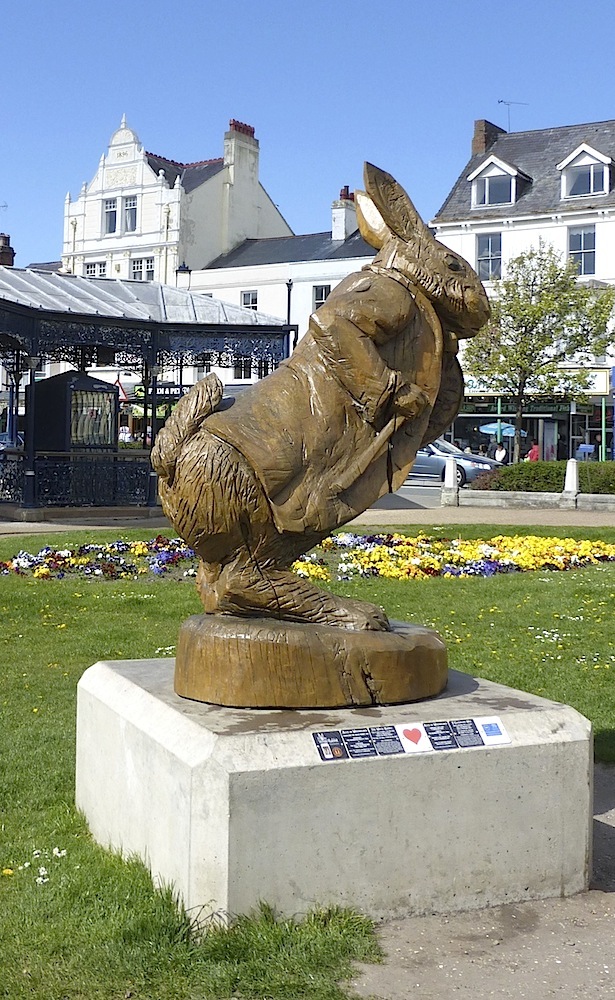
The White Rabbit in LLandudno, on the Alice trail — a wooden sculpture by Simon Hedger, installed in 2012.
Lewis Carroll, or (to give him his real name) Charles Dodgson, is associated with a number of localities. His birthplace in 1832 was Daresbury, Cheshire, but he spent his later childhood in Yorkshire at his father's Rectory in a village called Croft. As a student at Christ Church College, Oxford, from 1851, he spent some of his vacations in Ripon, where his father had become a canon of the Cathedral. And later on, as a mathematics don at Oxford, he frequented holiday resorts which would also claim a connection with him. Among these were Whitby in Yorkshire, where a blue plaque commemorates his visits, and Whitburn in Wearside, where in 1855 he wrote the Looking-Glass poem "Jabberwocky" while staying with his cousins (see Collingwood 143n.). From 1862, the Dean of Christ Church, father of Alice Liddell — the original inspiration for Dodgson's famous young heroine — had a summer home in Llandudno in North Wales. This too is felt to have inspired him, and now has an Alice trail. Then from 1872 Eastbourne in Sussex was his most regular holiday destination, although his visits to Brighton are also celebrated by a plaque in Sussex Square near the sea front. Next to Oxford, however, Dodgson was most closely and continuously associated with the pleasant town of Guildford in Surrey.
The Chestnuts
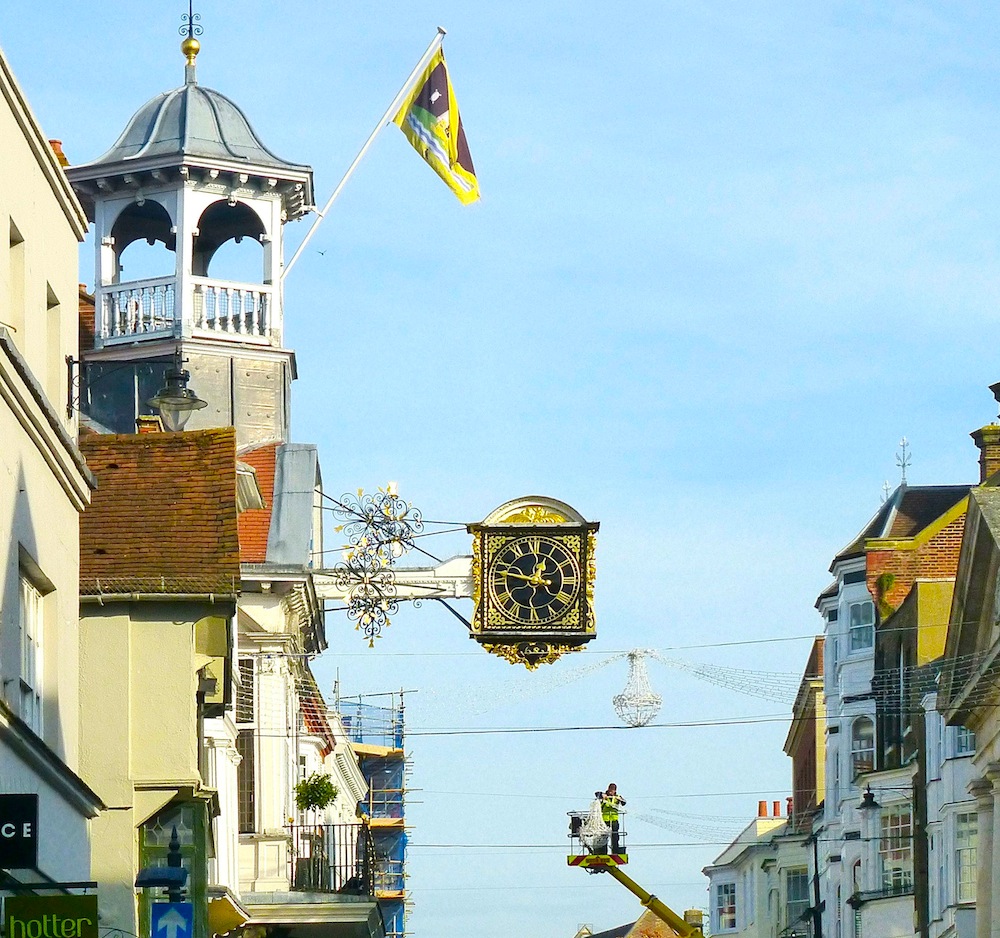
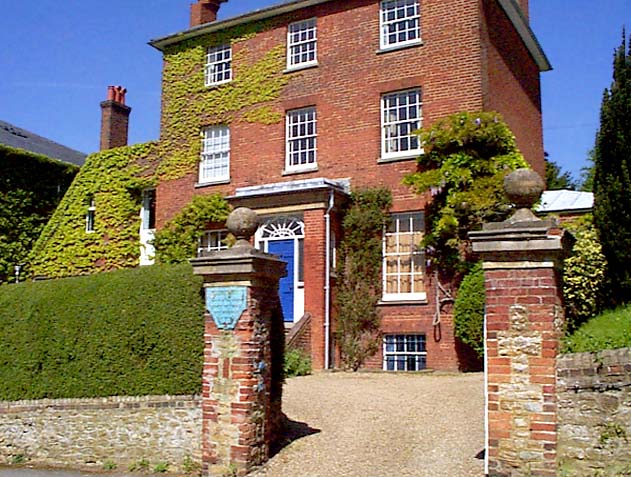
Left: Town Hall clock, Guildford High Street, dating from the seventeenth century. Right: The Chestnuts, taken a few years ago; the plaque on the gatepost is no longer there.
This association dates from 1868, when, as head of the household after his father's death, Dodgson acquired a house there for his family. The Chestnuts was a fine, solid brick-built house on Castle Hill, just behind Guildford Castle, and the Dodgsons were its first occupants. While he continued to make his own home at the college in Oxford, he not only spent parts of his holidays in Guildford but also joined in local life, making friends with the banker next door and the headmaster of the local Royal Grammar School. He attended church at St Mary’s on Quarry Street, the oldest building in the town, and was sometimes prevailed upon to preach there.
In many ways, Guildford was an ideal second home for him. Far from being a rural outback, the more southerly part of Surrey drew many big names in the literary world at this time. Tennyson himself, whom Dodgson had visited and photographed at his Isle of Wight residence, built a second home close to Haslemere, only a few stops away by train. Another iconic Victorian figure, George Eliot, wrote some of Middlemarch while staying near Haslemere too, and towards the end of her life bought The Heights (now Rosslyn Court) in Witley, near Godalming. Dodgson knew her work, and it was part of the contemporary literary scene against which he was reacting. George MacDonald, who rented Great Tangley Manor near Guildford in 1875, was a personal friend. In fact, the renowned Scottish author was one of those who had urged him to publish his first Alice manuscript. Another personal friend who moved nearby was Julia Huxley (née Arnold), Matthew Arnold's niece. She had been one of Dodgson's favourite child companions at Oxford. Her son Aldous would be born in Godalming, at their home called Laleham, in Dodgson's own lifetime.
For all these people, the train connections with London were a great attraction. Still better for Dodgson was the convenient journey from Oxford, involving just a change at Reading. As the eldest of four brothers as well as having seven sisters, he took his family responsibilities very seriously. Only one of his sisters, Mary, ever married. The rest, apart Henrietta who went to live in Brighton later on, remained in Guildford with their aunt, depending on him to look after their affairs for them. The Chestnuts was taken in his name, and he was on the electoral roll for Guildford. It was essential for him to be able to get there easily.
Guildford was also well placed for the south coast. From 1877, he travelled to Eastbourne summer after summer for twenty-one years, soon establishing himself in lodgings in Lushington Road near the station. A keen and gifted amateur photographer, he found ideal child subjects on the beach, dispensing safety-pins to little girls so that they could pin their skirts up when they paddled, and taking pictures of them. Such activities on the part of a now middle-aged man raised some eyebrows even at the time, and he was aware of this. On one occasion he wrote to his married sister from Lushington Road, in connection with the gossip about his having had a "particular girl-friend as a guest," that anyone in the public eye was "sure to be spoken about by somebody; and any action, however innocent in itself, is liable, and not at all unlikely to be blamed by somebody" (Selected Letters, 244). The subject is even more controversial now, but all that can be said with any certainty is that the children were not simply charming models but good partners in the various entertainments he created for them, with numbers, letters, cards and so on. It was a boon to find such a rich supply of them within easy travelling distance of Guildford.
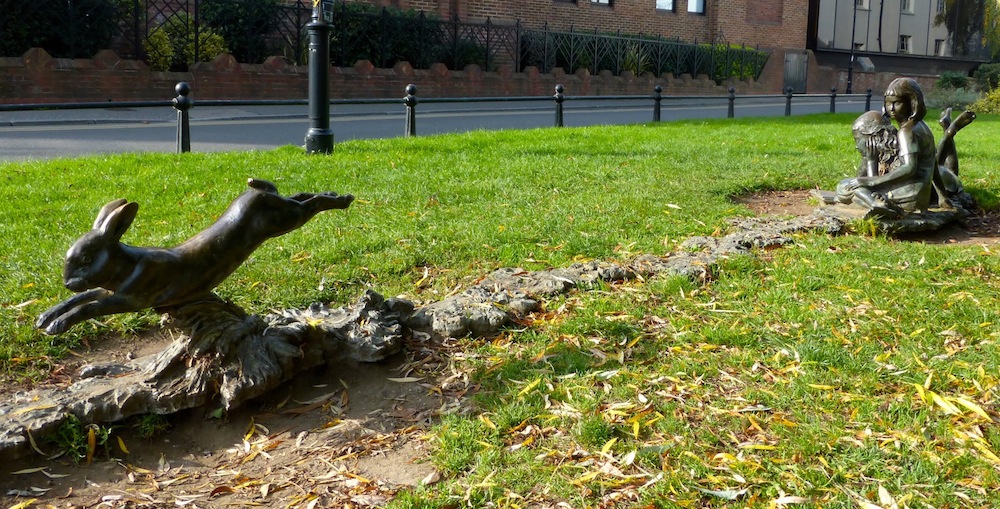
Bronze sculptures by Edwin Russell at Millmead, Guildford, of Alice with her sister, watching the rabbit spring down the rabbit-hole. The group was unveiled in 1984.
Quite apart from its strategic position, The Chestnuts was the perfect home for the Dodgson family. Gracious, Georgian-looking in style, and with four storeys and eight bedrooms, it was just the right size for his sisters and their aunt. It was also close to the town centre. When the Dodgsons had parties and gatherings, and the house itself was too full, he would stay at local inns, using The White Lion or The White Hart, both of which have been demolished now. The former is still remembered in the name of White Lion Walk.
Amongst his many connections in Surrey, Dodgson's most glamorous were with the royal family. From 1882 the Claremont estate at Esher was in the possession of Victoria's beloved youngest son, Leopold, who had gone to Christ Church. Dodgson had been present when Queen Victoria and Prince Albert visited the college, and now he was invited to Claremont, mingling with the royal family and their other important guests. There was a unique link between Prince Leopold and the Oxford don. Like Dodgson, the Prince had once been deeply attracted to Alice Liddell, There had been rumours of a possible engagement. Although Prince Leopold had gone on to marry the blue-blooded Princess Helen of Waldeck instead, he apparently still remembered his old love, for he named his only daughter Alice. Dodgson set himself to amuse this Alice, just as he had once amused her namesake, teaching her and her brother some tricks with paper. As always on such occasions, Dodgson obviously enjoyed the company of children, and his relationship with the young royal was a warm one (see Wakeling 324-30).
Guildford and Through the Looking Glass


Two of John Tenniel's illustrations for Through the Looking Glass. Left: The Guard, having demanded Alice's ticket in chapter 3, peers at her though a telescope. Right: The White Knight pictured propping up the o"Aged Man" who is rocking back and forth on the gate (in his song) in chapter 8.
As for Dodgson's writings during the Guildford period, the sequel to the first Alice book, Through the Looking Glass, was started in the very year that the family moved to The Chestnuts. It must have been a big upheaval for such a large family, as much of a change, no doubt, as it is for Alice when she goes through the glass and finds the family pictures and so on looking very strange in the "new" room on the other side. Inevitably, some of Dodgson's experiences are reflected in the unfolding narrative. In chapter 3, for example, Alice's train journey to the Fourth Square can be traced to one particular journey to Guildford. Dodgson had set off from Oxford in May 1869 with a girl called Isabel who was going to London, and he mistakenly kept her ticket with him when he changed at Reading. He wrote at once to apologise:
Words cannot tell how horrified, terrified, petrified (everything ending with "fied," including all my sisters here saying "fie!" when they heard it) I was when I found out that I had carried off your ticket to Guildford.... I hardly dare ask what happened at Paddington....
Pretending to fear that Isabel might have been sent to prison, he promises to try his best to get her out, adding, "at any rate you shan't be executed" (Looking Glass Letters, 82). In the book, Alice, who also finds herself travelling without a ticket, is scrutinised by an angry Guard. He looks at her through a telescope, microscope and opera glasses, before announcing that she is travelling the wrong way. Her unusual fellow-passengers (they include a goat and a horse), then make some extraordinary suggestions — that she should go back as luggage, draw the train herself, and so on — until the train suddenly leaves the tracks and Alice finds herself under a tree.
Not all the details here would have been inspired by Dodgson's fantasies about the ticketless Isabel. Others came from everyday life. The late August 1868 issues of both the Saturday Review and the Illustrated London News had both carried articles train safety, and derailments continued to occur with alarming regularity. Tennyson used to worry about his sons' train journeys to and from Haslemere, for instance. Another topical detail here is the passengers' explanation for Alice's failure to find a ticket office: "There wasn't room for one where she came from," they chorus to the Guard. "The land there is worth a thousand pounds an inch!" There speaks an author who had recently been hunting for a large family house on the new rail network!
Other local references in this second Alice book include those to Tennyson himself, now starting his residence at Haslemere. Dodgson's relationship with the poet had soured, and he pokes fun at him and his boys in the White Knight and the quarrelsome Tweeledum and Tweedledee. The most obvious (and irreverent) references to Tennyson himself are in the White Knight's song about "The Aged, Aged Man"
Whose face was very like a crow,
With eyes, like cinders, all aglow,
Who seemed distracted with his woe,
Who rocked his body to and fro,
And muttered mumblingly and slow,
As if his mouth were full of dough,
Who snorted like a buffalo.... [164-65]
Tennyson liked to wear black, was dark-complexioned with dark, restless eyes, and suffered from melancholy and hay-fever. Moreover, he was known for his interminable recitations, which Dodgson, being deaf in one ear, would have found particularly hard to catch. Dodgson sent presentation copies of both the Alice books to the poet, but whether Tennyson recognised himself here is not known!
Guildford and The Hunting of the Snark
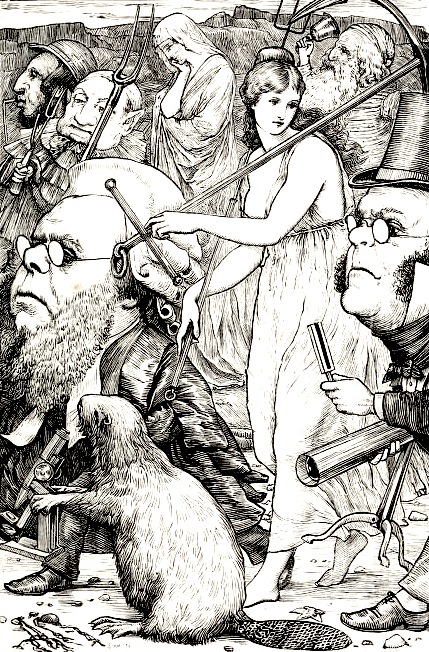
In pursuit of the Snark: Henry Holiday's illustration for Fit the Fourth, in The Hunting of the Snark (source: Macmillan ed., facing p. 34).
There was a third "nonsense" work yet to come. This is the poem entitled The Hunting of the Snark, which is not as famous as the Alice books, but still has a cult following. It owed its inspiration entirely to Dodgson's Guildford experience. He was there in July 1874, helping to look after a sick relative, when he took a walk on the Surrey downs for a breath of fresh air. A line of nonsense came into his head: "For the Snark was a Boojum, you see." Once he had written it down, the rest of this strange poem began to form, developing over the next year or two into 141 four-lined stanzas in eight "Fits." These tell the story of a Barrister, Broker, Banker and other crew members whose hunting expedition ends with the disappearance of the Baker. This poor man, who had already been warned by an uncle that some Snarks are terribly dangerous "Boojums," and had fainted away when reminded of this by the Bellman, has apparently been devoured by one of them.
In the midst of the word he was trying to say,
In the midst of his laughter and glee,
He had softly and suddenly vanished away —
For the Snark was a Boojum, you see. [96]
Like the Alice books, this has been taken as a spoof on Victorian society, or even as a comment on the tragic nature of human life, and the fear of non-existence (see Gardner 21ff.). Although such interpretations are disputed by those who relish the sheer verbal inventiveness of the poem, the idea for it certainly came to Dodgson at a sad time. Unfortunately, the cousin whose sickbed he was attending in Surrey did "vanish away" from tuberculosis.
It helps to see Dodgson in his Surrey setting. He was not, after all, simply an eccentric Oxford don with his head in the clouds. In real life, family responsibilities demanded that he set at least one foot on the solid ground of home-counties' England. In his writing, too, he not only played games with his child readers, but gave plenty of scope to scholars who see dark undertows of reality beneath his phantasmagoric narratives and weird characters. Of course, all the truly great classics of children's literature can be read on different levels. Yet there is another twist to Dodgson's tale. By mixing "stuff and nonsense" in such an unpredictable way, he inspired new generations of writers as well as readers, setting the scene for the stream-of-consciousness techniques, surrealism and absurdism of the next century. The history of the modern novel might have been very different without the input of his extraordinarily inventive mind.
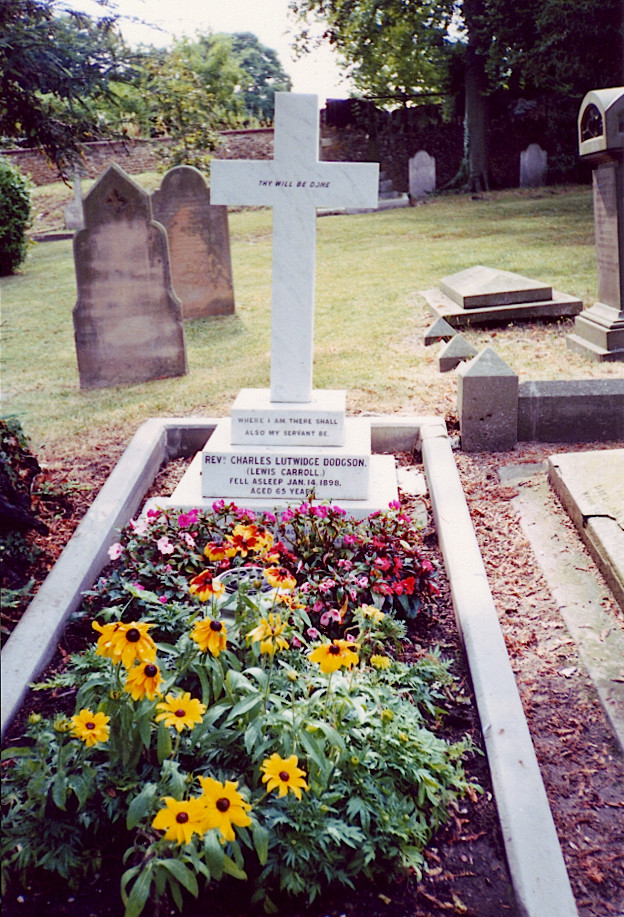
Dodgson's grave in the Mount Cemetery Guildford.
Dodgson died at Guildford on 14 January 1898. He was not quite sixty-six, but his health had been poor in recent years, and he had grown very thin. When he caught influenza on his Christmas visit, not even the loving care of his sisters could help him. The funeral service was held at St Mary's, and he was buried in the Mount Cemetery, where his Aunt Lucy and several of his sisters are also buried. The grave is still bright with flowers.
Bibliography
Carroll, Lewis. The Hunting of the Snark: An Agony, in Eight Fits. London: Macmillan, 1876. Internet Archive. Contributed by the University of California Libraries [source of illustration]. Web. 15 January 2017.
_____.The Looking-Glass Letters. Ed. Thomas Hinde. London: Collins and Brown, 1991.
_____. The Selected Letters of Lewis Carroll. Ed. Morton N. Cohen, with the assistance of Roger Lancelyn Green. 2nd ed. London: Palgrave, 1989.
Collingwood, Stuart Dodgson Collingwood. The Life and Letters of Lewis Carroll. New York: Century, 1899. Internet Archive. Contributed by the Library of Congress. Web. 15 January 2017.
Gardner, Martin. Introduction. The Hunting of the Snark. Harmondsworth: Penguin Classics, 1995. 15-31.
Jones, Jo Elwyn, and J. Francis Gladstone. The Alice Companion: A Guide to Lewis Carroll's Alice Books. London: Macmillan, 1998.
Wakeling, Edward. Lewis Carroll: The Man and His Circle. London: I. B. Tauris, 2015 [Review].
Created 15 January 2017